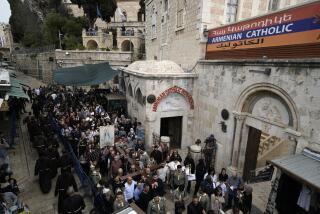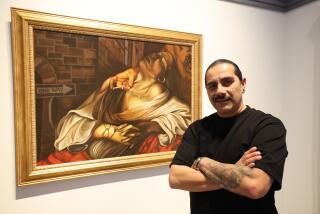‘The Sacred Made Real’ at National Gallery
Any tourist quickly senses something different in the churches of Spain. Unlike the pure idealized figures of Christ in most of the rest of Europe, those of Spain seem to bleed. The skins show bruising, the eyes droop in anguish, the feet gnarl in pain.
Spain’s realistic sculptures of Christ and Christian saints usually leave their churches and monasteries only once a year. They are placed on massive floats and carried by strong men in the processions of Holy Week. Hooded penitents walk behind barefoot, some striking their backs with the cords of a whip.
The painted wooden sculptures, most created in the 17th century, are regarded as some of Spain’s finest works of art. But, still venerated for their religious power, they are seldom seen in a museum.
Now, a small number have been assembled for an exhibition titled “The Sacred Made Real” that has opened at the National Gallery of Art in Washington and will remain there until the end of May. Alongside the sculptures are religious paintings by great Spanish artists, especially Diego Velázquez and Francisco de Zurbarán, who were influenced by the sculptures.
The show, which won critical acclaim at the National Gallery in London last year, was put together by Xavier Bray, the London museum’s assistant curator of 17th and 18th century European paintings. After closing in Washington, it will go nowhere else.
The sculptures were created, as the museum’s guide booklet for the exhibition puts it, “to shock the senses and stir the soul.” Spain looked on itself as the vanguard of the church’s Counter-Reformation, the movement to purify and strengthen Catholicism in its struggle against the breakaway Protestant Reformation. The sculptures played a vital part.
Protestants, in one of their grievances, had accused Catholic priests of standing between their parishioners and the Christ and saints they worshiped. The astonishing reality of the sculptures, says Bray, met this complaint by making worshipers feel close to those they venerated. Priests also hoped that the sculptures would galvanize the enthusiasm of thousands of descendants of former Jews and Muslims who had been pressured or forced into Christianity in Spain.
Sculptures were usually created by a pair of artists -- a wood sculptor and a painter. Most sculptors could not finish the job themselves because they belonged to the guild of carpenters but not the guild of painters. The law required that the final work on these pieces had to be done by a qualified “painter of imagery” -- someone trained in polychrome (or many-colored) painting on religious statues.
The most renowned sculptor was probably Juan Martínez Montañés, known as “the god of wood,” and the master polychrome painter was surely Francisco Pacheco, the teacher and later father-in-law of Velázquez. The exhibition includes two of their joint works, a 1610 St. Ignatius Loyola and a 1624 St. Francis Borgia (both from the church of Seville University).
The collaborators turned on each other in later years. Like most sculptors, Montañés grew increasingly frustrated over the rules that prevented him from painting his own works. To demonstrate the primacy of his own role, he signed a contract with a Seville convent that gave him 75% of the payment for an altarpiece and only 25% for the polychrome painter (someone other than Pacheco).
The contract infuriated the painters guild and prompted Pacheco to write a treatise on the importance of painting the sculptures. He insisted that polychrome painting revealed “the passions and concerns of the soul with great vividness.”
The vital role of paint is demonstrated in the exhibition by the dark facial tones Pacheco used on the Borgia statue. These tones avoided any kind of shiny brilliance and gave Borgia a somber pallor with dark shades emphasizing the ascetic hollows of his cheekbones. Any painter like Velázquez or Zurbarán who trained in the religious art center of Seville would have learned how to paint wooden statues. In fact, a contract has been found in which Zurbarán agreed to paint a Crucifixion, but the work has not been located.
Velázquez knew Montañés well. When the Seville painter came to Madrid to prepare an equestrian model of King Philip IV, Velázquez, then a court painter in Madrid, painted a portrait of Montañés (now in the Prado in Madrid) that is included in the exhibition.
A few sculptors fulfilled the requirements for both the guild of carpenters and the guild of painters and could therefore paint their own works. Pedro de Mena, one of the few, sculpted and painted his Christ as the Man of Sorrows (now owned by the royal convent of Barefoot Franciscan nuns in Madrid) in Malaga in 1673.
Mena created half-length pieces like this because he evidently felt they would draw worshipers close to them for an intense, intimate experience. The wounds are so realistic that they can be hard for modern viewers to take. To heighten the realism, Mena inserted glass eyes, eyelashes made from hair, and ivory or bone teeth.
The exhibition demonstrates that 17th century Spanish painters were influenced by the religious wood sculptures that they knew well and had been trained to paint. This familiarity lent a sculptural or three-dimensional look to their canvases.
This was especially true of Zurbarán. His 1627 Christ on the Cross painting (from the Chicago Art Institute) was often mistaken for a sculpture when it hung above an altar at the church of a Dominican friary in Seville.
But there was one significant difference. This Zurbarán is shown near a 1617 sculpted Christ of the Cross by Montañés and an unknown painter (from the church of a Barefoot Carmelite convent in Seville). Although Zurbarán’s lifeless Christ is realistic with face, hands and feet turning gray, it lacks all the bleeding of Montañés’ even more realistic sculpture. Bray explains that the lack of blood was because of the teaching of Pacheco, who warned painters that splatters of red would overwhelm their canvases.
Although the exhibition comprises only 11 sculptures and 11 paintings, borrowing the wooden statues from Spanish religious institutions was an extraordinary feat. Bray says, for example, that a small 1663 statue by Pedro de Mena, known as St. Francis Standing in Ecstasy, had never left the Toledo Cathedral before. “It took 17 letters and a promise to restore it,” says Bray, before church authorities agreed to let it go. Bray was so persistent in his entreaties that he jokes, “I was almost excommunicated several times.”
More to Read
The biggest entertainment stories
Get our big stories about Hollywood, film, television, music, arts, culture and more right in your inbox as soon as they publish.
You may occasionally receive promotional content from the Los Angeles Times.






